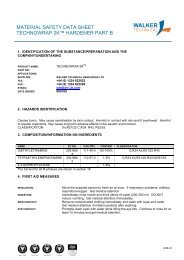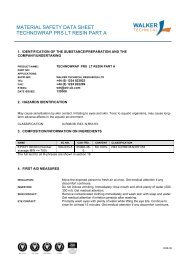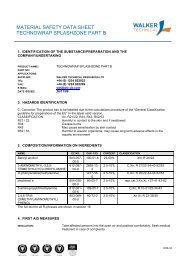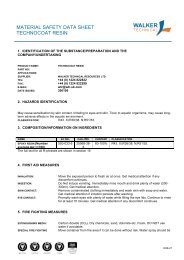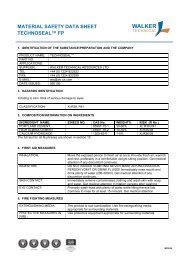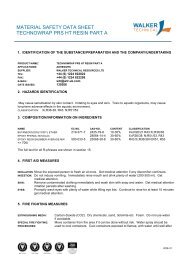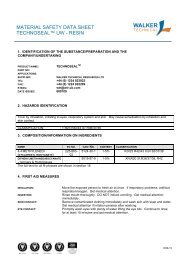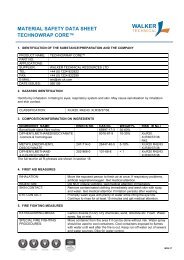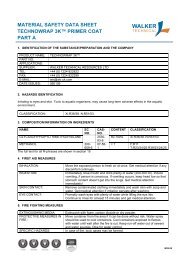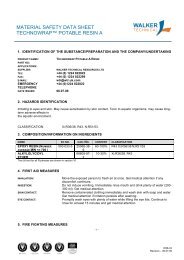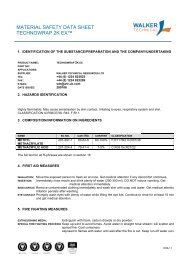material safety data sheet technowrap 3k primer ... - PT. Harimau Putih
material safety data sheet technowrap 3k primer ... - PT. Harimau Putih
material safety data sheet technowrap 3k primer ... - PT. Harimau Putih
Create successful ePaper yourself
Turn your PDF publications into a flip-book with our unique Google optimized e-Paper software.
MATERIAL SAFETY DATA SHEETTECHNOWRAP 3K PRIMER COAT PART B1. IDENTIFICATION OF THE SUBSTANCE/PREPARATION AND THECOMPANY/UNDERTAKINGPRODUCT NAME:TECHNOWRAP 3K PRIMER COAT PART B - METHANOLPART NO:APPLICATIONS:SUPPLIER:WALKER TECHNICAL RESOURCES LTDTEL: +44 (0) 1224 822822FAX: +44 (0) 1224 822299E-MAIL:WTR@WTR.UK.COMDATE ISSUED: 08/09/092. HAZARDS IDENTIFICATIONHighly flammable. Toxic by inhalation, in contact with skin and if swallowed. Toxic: danger of very seriousirreversible effects through inhalation, in contact with skin and if swallowed.CLASSIFICATION: T;R23/24/25,R39/23/24/25, F;R113. COMPOSITION/INFORMATION ON INGREDIENTSNAME EC NO. CAS- NO. CONTENT CLASSIFICATIONMETHANOL 200-659-6 67-56-1 60-100% F;R11 T;R23/24/25,R39/23/24/25The full text for all R-phrases are shown in section 164. FIRST AID MEASURESINHALATION:INGESTION:Move the exposed person to fresh air at once. Perform artificial respiration if breathinghas stopped. Keep the affected person warm and at rest. Get prompt medical attention.When breathing is difficult, properly trained personnel may assist affected person byadministering 100% oxygen.DO NOT induce vomiting! Get medical attention immediately! Rinse mouththoroughly. Drink plenty of water (200-300ml) . Provide rest, warmth and freshair.SKIN CONTACT: Remove affected person from source of contamination. Immediately removecontaminated clothing flushcontaminated skin with soap and water. Seek medical attentionif irritation persistsYEYE CONTACT:Promptly wash eyes with plenty of water while lifting the eye lids. Continue to rinse forat least 15 minutes and get medical attention.W28-25
MATERIAL SAFETY DATA SHEETTECHNOWRAP 3K PRIMER COAT PART B5. FIRE FIGHTING MEASURESEXTINGUISHING MEDIA:SPECIAL FIRE FIGHTINGPROCEDURES:SPECIFIC HAZARDS:PROTECTIVE MEASURES INFIRE:DO NOT use water if avoidable. Carbon Dioxide (CO2). Dry chemicals, sand,dolomite etc. FoamMove container from fire area if it can be done without risk. Water spray shouldbe used to cool containers. Cool containers exposed to flames with water untilwell after the fire is out. Keep run-off water out of sewers and water sources.Dike for water control.In case of fire, toxic gases may be formed. Fire creates: Carbon Monoxide(CO). Carbon Dioxide (CO2)Use protective equipment appropriate for surrounding <strong>material</strong>s. Self containedbreathing apparatus and full protective clothing MUST be worn.6. ACCIDENTAL RELEASE MEASURESPERSONAL PROTECTIONS:ENVIRONMENTALPRECAUTIONS:SPILL CLEAN-UP METHODS:Where a spill has occurred beware of slippery floors and surfaces. Avoidinhalation of vapours and contact with skin and eyes. Adequate ventilation isnecessary. Wear protective clothing as described in Section 8 of this <strong>data</strong><strong>sheet</strong>.Avoid release to the environment. Do not discharge into drains, water coursesor onto the ground. Contain spillages with sand, earth orany suitable adsorbent<strong>material</strong>. The product should not be dumped in nature but collected anddelivered according to agreement with the local authorities.Extinguish all ignition sources. Avoid sparks, flames, heat and smoking.Ventilate. Wear necessary protective equipment. Stop leak if possible withoutrisk. Absorb in vermiculite, dry sand or earth and place into containers.Containers with collected spillage must be properly labelled with correctcontents and hazard symbol. Runoff or release to sewer, waterway or ground isforbidden. Flush area clean with lots of water. Be aware of potential for surfacesto become slippery. Clean-up personnel should use respiratory and/or liquidcontact protection.7. HANDLING AND STORAGEUSAGE PRECAUTIONS:STORAGE PRECAUTIONS:STORAGE CLASS:Avoid spilling, skin and eye contact. Ventilate well, avoid breathing vapours. Useapproved respirator if air contamination is above accepted level. Keep away fromheat, sparks and open flame. Do not eat, drink or smoke when using the product.Flammable/combustible – Keep away from oxidizers, heat and flames. May attacksome plastics, rubber and coatings. Keep in cool dry ventilated storage andclosed containers. Ground containers and transfer equipment to eliminate staticelectric sparks. Protect from light, including direct sunrays. Store separated from:Acids, Alkalies, Oxidising <strong>material</strong>.Flammable liquid storage.8. EXPOSURE CONTROLS AND PERSONAL PROTECTIONW28-25
MATERIAL SAFETY DATA SHEETTECHNOWRAP 3K PRIMER COAT PART BNAME Std LT - ppm LT – mg/m3 ST- ppm ST – mg/m3METHANOL WEL 200 PPM 266 MG/M3 250 PPM(SK) 333 MG/M3 (SK)(SK)(SK)PROTECTIVE EQUIPMENT:PROCESS CONDITIONS:ENGINEERING MEASURES:RESPIRATORY EQUIPMENT:HAND PROTECTION:EYE PROTECTION:HYGIENE MESURES:SKIN PROTECTION:Provide Eyewash StationExplosion proof general and local exhaust ventilationType approved RPE for organic vapours if OES is likely to be exceeded. Chemicalrespirator with organic vapour cartridge.Use protective gloves made of: Butyl rubber. Polyvinylidene chloride/Polyethylene(PVD/PE)Wear approved <strong>safety</strong> goggles. Wear splash proof eye goggles to prevent anypossibility of eye contact. Use face shield in case of splash risk.Wear appropriate clothing to prevent repeated or prolonged skin contact. Wash atthe end of each work shift and before eating, smoking and using the toilet. Washpromptly with soap & water if skin becomes contaminated. When using do not eat,drink or smoke.OES = Occupational Exposure Standards (EH40). (SK) = Able to be absorbedthrough intact skin.Wear apron or protective clothing in case of splashes.9. PHYSICAL AND CHEMICAL PROPERTIESAPPEARANCE:COLOUR:ODOUR:SOLUBILITY:Liquid. Clear. MobileColourlessAlcohol. Characteristics. Pungent.Miscible with water. Miscible with:Ethanol, ether, Benzene, Organic solvents(most).BOILING POINT/RANGE: ~64 760 mm Hg ( o C)VAPOUR DENSITY (air=1): 1.11 RELATVITY DENSITY: 0.79 20FLASH POINT ( O C) 9.5 CC (CLOSED CUP) MELTING POINT ( O C): ~ -97AUTO IGNITION TEMPERATURE ( O C) 470 FLAMMABILITY LIMIT – LOWER(%): 6.70FLAMMABILITY LIMIT – UPPER(%): 3610. STABILITY AND REACTIVITYW28-25
MATERIAL SAFETY DATA SHEETTECHNOWRAP 3K PRIMER COAT PART BSTABILITY:CONDITIONS TO AVOID:MATERIALS TO AVOID:HAZARDOUSDECOMPOSITIONStable under normal temperature conditions and recommended use.Avoid heat, sparks, flames, and other sources of ignition. Moisture.TRICHLOROMETHANE. CHROMIUM TRIOXIDE. PERCHLORIC ACID. PERCHLORYL FLUORIDE.POTASSIUM-tert-BUTOXIDE. Chlorine. Aluminium Magnesium Strong oxidizing agents. Strong acids andStrong alkalis.Toxic gases/vapours/fumes of Carbon monoxide (CO). Carbon Dioxide (CO2)11. TOXICOLOGICAL INFORMATIONTOXIC DOSEINHALATION:INGESTION:SKIN CONTACT:EYE CONTACT:1 LD 50 5628.00 mg/kg (oral rat)Toxic: DANGER OF VERY SERIOUS IRREVERSIBLE EFFECTS THROUGHINHALATION.Toxic: DANGER OF WERY SERIOUS IRREVERSIBLE EFECTS IF INGESTEDToxic: DANGER OF VERY SERIOUS IRREVERSIBLE EFFECTS IF INCONTACT WITH SKIN.Extreme irritation of eyes and mucous membranes, including burning and tearing. Visualdisturbances,incl blurred visions.ROUTE OF ENTRY:Inhalation. Skin and/or eye contact. IngestionTARGET ORGANS:Respiratory system, lungs. Skin. Eyes. Gastro-intestinal tract. Kidneys. LiverMEDICAL SYM<strong>PT</strong>OMS: Respiratory failure, death. Severe skin irritation. Nausea, vomiting. Headache.Behavioural changes,tremors, convulsions, lachrymation, blurred vision after liquid splashMEDICAL CONSIDERATIONS: Convulsive disorders, CNS problems. Splash in eye requires examination by eyespecialist.12. ECOLOGICAL INFORMATIONEXOTOXICITY:The product should not be allowed to enter drains or water-courses, or to bedeposited where it can effect ground or surface waters.BIOACCUMULATION: Low potential for bioaccumulation.DEGRADABILITY:Expected to be biodegradableLC50, 96 HRS, FISH mg/l: >20,000EC50, 48 HRS, DAPHNIA mg/l: >10,00013. DISPOSAL CONSIDERATIONSW28-25
MATERIAL SAFETY DATA SHEETTECHNOWRAP 3K PRIMER COAT PART BDISPOSAL METHODS:Via an authorised waste disposal contractor to an approved waste disposal site,observing all local and national regulations. Not to allow runoff into sewer,waterway or ground.14. TRANSPORT INFORMATIONLABEL (S) FOR CONVEYANCE:ToxicFlammable LiquidUK ROAD CLASS: 3PROPER SHIPPING NAME: METHANOLUN NO ROAD: 1230 UK ROAD PACK GR. IIADR CLASS NO: 3 ADR CLASS: 3 Flammable liquidsADR PACK GROUP: II HAZARD NO: (ADR): 336ADR LABEL NO: 3 & 6.1 HAZCHEM CODE:: 2WECEFIC TEC (R) NO: 30GFT1-II RID CLASS NO: 3RID PACK GROUP: II UN NO SEA: 1230IMDG CLASS: 3 EMS: F-E, S-DMFAG:MARINE POLLUTANT:UN NO AIR: 1230 ICAO CLASS:AIR PACKAGE GR:II15. REGULATORY INFORMATIONLABELLING:HIGHLY FLAMMABLETOXICCONTAINS:RISKPHRASES:METHANOLR-11 Highly flammableR-23/24/25 Toxic by inhalation, in contact with skin and if swallowedW28-25
MATERIAL SAFETY DATA SHEETTECHNOWRAP 3K PRIMER COAT PART BSAFETYPHRASES:R39/23/24/25 Toxic: Danger of very serious irreversible effects through inhalation, in contact with skinand if swallowedS-9 Keep container in a well-ventilated place.S-16 Keep away from sources of ignition – No SmokingS-36/37/39 Wear suitable protective clothing and gloves, and eye/face protectionS-45 In case of accident or if you feel unwell, seek medical advice immediately (show the labelwhere possible)S-7 Keep container tightly closedS38 In case of insufficient ventilation, wear suitable respiratory equipment.S60 This <strong>material</strong> and its container must be disposed of as hazardous waste.UK REGULATORYHealth and Safety at Work Act 1974REFERENCES:EU DIRECTIVES:System of specific information relating to Dangerous Preparations. 2001/58/EC.Dangerous Substance Directive 67/548/EEC. Regulation(EC) No 1907/2006 of the European Parliament and of the Council of 18December 2006 concerning the Registration, Evaluation,Authorisation and Restriction of Chemicals (REACH), establishing a EuropeanChemicals Agency, amending Directive 1999/45/EC andrepealing Council Regulation (EEC) No 793/93 and Commission Regulation (EC)No 1488/94 as well as Council Directive 76/769/EEC andCommission Directives 91/155/EEC, 93/67/EEC, 93/105/EC and 2000/21/EC,including amendments.STATUTORY INSTRUMENTS:APPROVED CODE OFPRACTICE:GUIDANCE NOTES:Chemicals (Hazard Information and Packaging for Supply) Regulations 2002 (SI1689)Control of Substances Hazardous to Health Regulations 2002Workplace Exposure Limits EH4016. OTHER INFORMATIONREVISION DATE: 10/08/10REV. NO./REPL. SDS02/02/06GENERATED:SDS No:SAFETY DATA SHEET ApprovedSTATUS:R-PHRASES IN R36/38FULL:R43R51/53DISCLAIMERTHIS INFORMATION RELATES ONLY TO THE SPECIFIC MATERIAL DESIGNATED AND MAY NOT BE VALID FOR SUCH MATERIAL USED IN COMBINATIONWITH ANY OTHER MATERIALS OR IN ANY PROCESS. SUCH INFORMATION IS, TO THE BEST OF THE COMPANY’S KNOWLEDGE AND BELIEF, ACCURATEAND RELIABLE AS OF THE DATE INDICATED. HOWEVER, NO WARRANTY, GUARANTEE OR REPRESENTATION IS MADE AS TO ITS ACCURACY,RELIABILITY OR COMPLETENESS. IT IS THE USER’S RESPONSIBILITY TO SATISFY HIMSELF AS TO THE SUITABILITY OF SUCH INFORMATION FOR HISOWN PARTICULAR USE.W28-25



